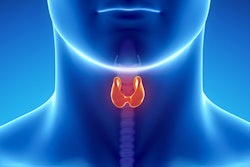
Researchers from the U.S. and Taiwan have identified an association between radiation exposure from CT scans and an increased risk of thyroid cancer and leukemia in a large-scale, population-based study. The findings are covered in an article published online on November 19 in JNCI Cancer Spectrum.
As medical imaging usage rates grow exponentially across the globe, healthcare providers and members of the general public have expressed concern over the potential harms of excessive radiation exposure. A large-scale study out of South Korea recently heightened this apprehension, linking radiation-based imaging exams such as CT and PET to increased cancer risk in individuals 19 and younger.
For the current study, a group led by Yu-Hsuan Shao, PhD, of Taipei Medical University Hospital examined the data of roughly 3.4 million adults who were beneficiaries of the Taiwan National Health Insurance between 2000 and 2013.
Among the beneficiaries, roughly 56,000 were diagnosed with thyroid cancer, leukemia, or non-Hodgkin's lymphoma. This subcohort of cancer patients excluded individuals younger than 25, those who received treatments requiring a high dose of radiation, and those who underwent a CT scan for any cancer-related indication or less than three years before a cancer diagnosis.
Over the 13-year period, the researchers found a statistically significant association between CT radiation exposure and an increased risk of thyroid cancer and leukemia among all beneficiaries. They also found a statistically significant association between CT radiation and increased risk of non-Hodgkin's lymphoma, but only in individuals between the ages of 36 and 45.
The likelihood of developing thyroid cancer was 2.55 times greater for those who underwent CT than for those who did not receive CT. For leukemia, CT was associated with a 1.55-times higher risk of cancer.
| Association between CT radiation exposure and cancer in adults | ||
| No CT | CT | |
| Thyroid cancer incidence rate* | 1.6% | 4% |
| Leukemia incidence rate* | 3.7% | 5.7% |
| Non-Hodgkin's lymphoma incidence rate | 4.8% | 5% |
What's more, the researchers identified a statistically significant relationship between greater radiation exposure and increased risk of the three cancer types in all patients 45 years old and younger (p < 0.001). For example, the risk of thyroid cancer roughly doubled for the individuals when their CT radiation exposure increased from a low (1 mSv to 15 mSv) to medium dose range (16 mSv to 30 mSv), and their risk nearly tripled when their exposure increased from a medium to high dose range (more than 30 mSv).
Further analysis revealed that the association between CT radiation exposure and increased cancer risk held true even when excluding patients who received CT scans less than 10 years before a cancer diagnosis. Subanalysis of the data also showed that the association was stronger in women than in men.
"CT scans are an important diagnostic tool, but [they] need to be used judiciously. ... Additionally, strategies to reduce radiation exposure from an appropriate utilization of medical imaging would definitely optimize the benefit-risk ratio of CT scans," the authors concluded.



















